Strategic Management Report: Global Motor Vehicle Industry Overview
VerifiedAdded on 2022/09/16
|8
|1777
|11
Report
AI Summary
This report provides a strategic management analysis of the global motor vehicle industry, focusing on the application of the five forces model and PEST analysis to understand industry dynamics. It examines the competitive landscape, including the threat of new entrants, rivalry among existing firms, the threat of substitutes, and the bargaining power of suppliers and buyers. The PEST analysis delves into political, economic, social, and technological factors influencing the industry. The report further explores the reasons behind the shift from manufacturing to importing motor vehicles in Australia, highlighting economic factors such as high manufacturing costs, a small domestic market, and the impact of government policies. The report concludes by referencing key sources that support the analysis of the automotive industry, offering a comprehensive overview of its strategic management.
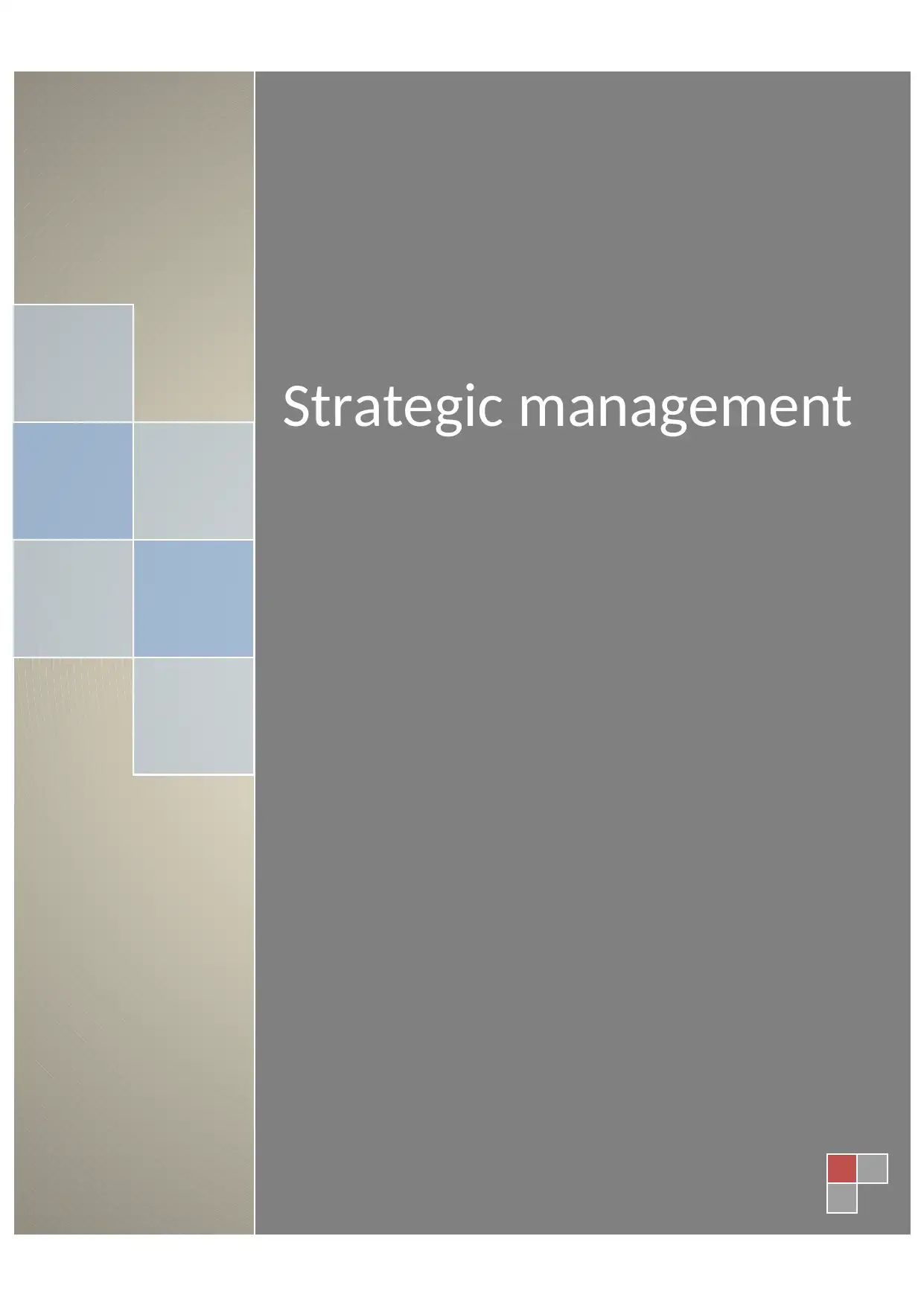
Strategic management
Paraphrase This Document
Need a fresh take? Get an instant paraphrase of this document with our AI Paraphraser
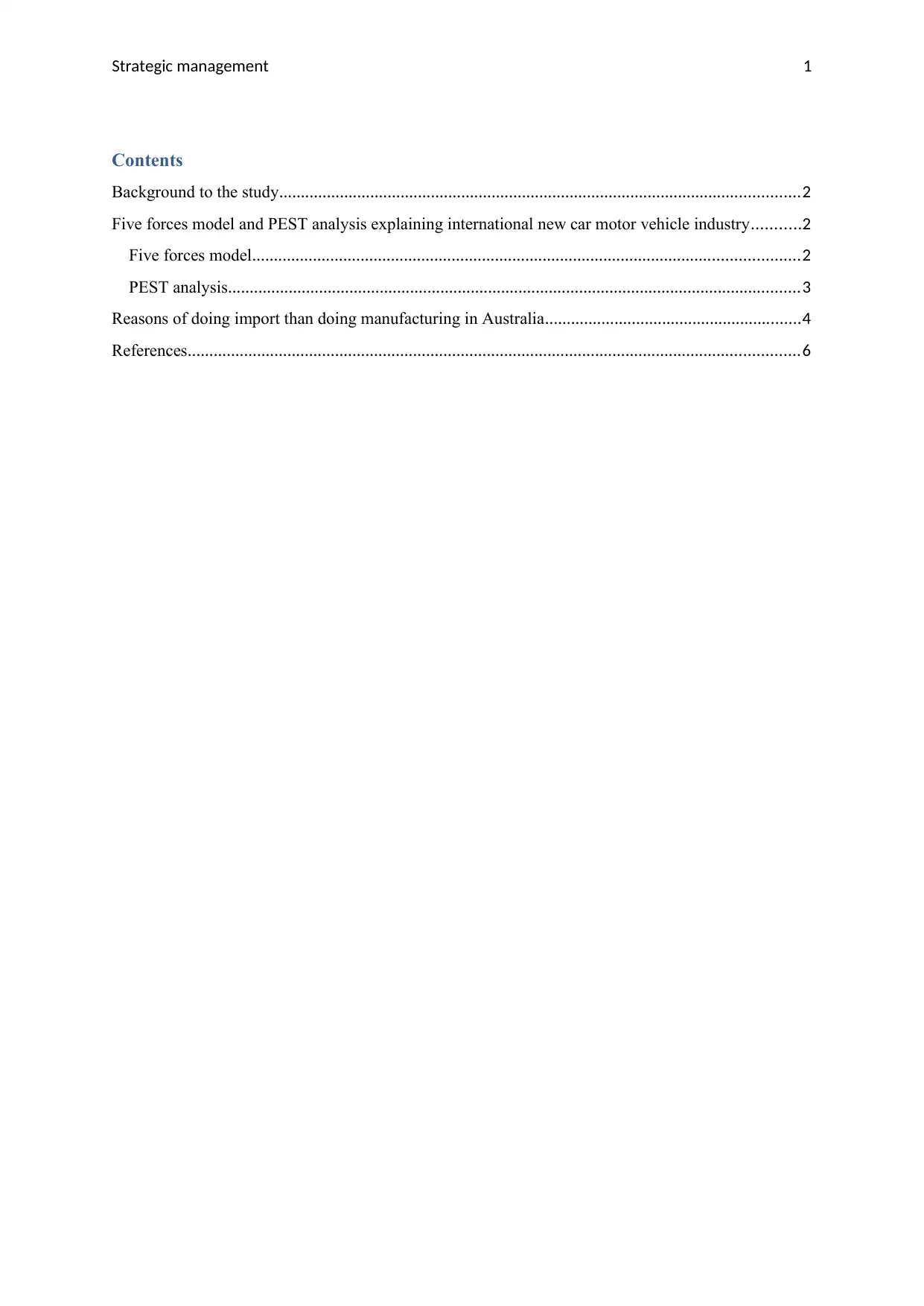
Strategic management 1
Contents
Background to the study........................................................................................................................2
Five forces model and PEST analysis explaining international new car motor vehicle industry...........2
Five forces model..............................................................................................................................2
PEST analysis....................................................................................................................................3
Reasons of doing import than doing manufacturing in Australia...........................................................4
References.............................................................................................................................................6
Contents
Background to the study........................................................................................................................2
Five forces model and PEST analysis explaining international new car motor vehicle industry...........2
Five forces model..............................................................................................................................2
PEST analysis....................................................................................................................................3
Reasons of doing import than doing manufacturing in Australia...........................................................4
References.............................................................................................................................................6
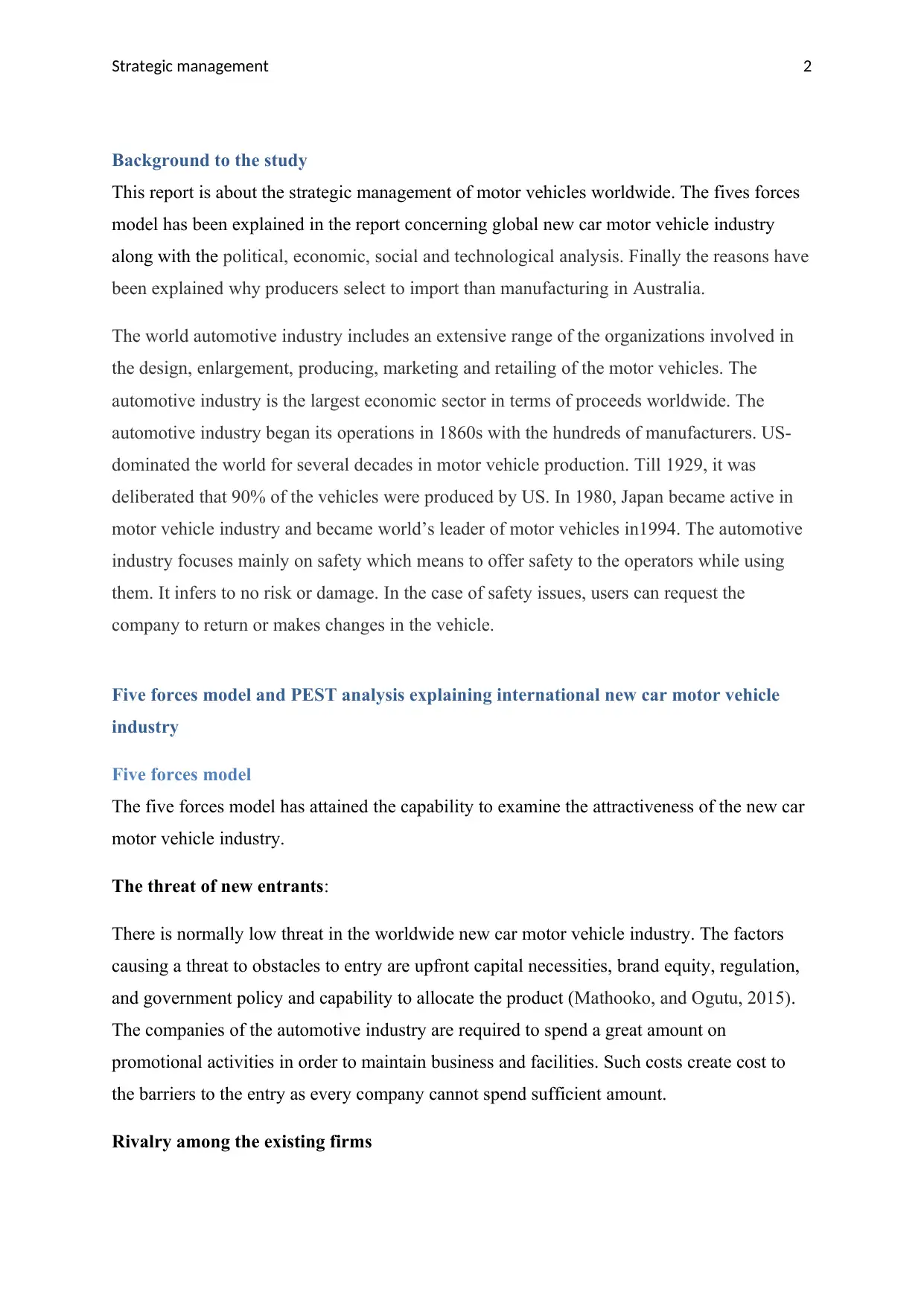
Strategic management 2
Background to the study
This report is about the strategic management of motor vehicles worldwide. The fives forces
model has been explained in the report concerning global new car motor vehicle industry
along with the political, economic, social and technological analysis. Finally the reasons have
been explained why producers select to import than manufacturing in Australia.
The world automotive industry includes an extensive range of the organizations involved in
the design, enlargement, producing, marketing and retailing of the motor vehicles. The
automotive industry is the largest economic sector in terms of proceeds worldwide. The
automotive industry began its operations in 1860s with the hundreds of manufacturers. US-
dominated the world for several decades in motor vehicle production. Till 1929, it was
deliberated that 90% of the vehicles were produced by US. In 1980, Japan became active in
motor vehicle industry and became world’s leader of motor vehicles in1994. The automotive
industry focuses mainly on safety which means to offer safety to the operators while using
them. It infers to no risk or damage. In the case of safety issues, users can request the
company to return or makes changes in the vehicle.
Five forces model and PEST analysis explaining international new car motor vehicle
industry
Five forces model
The five forces model has attained the capability to examine the attractiveness of the new car
motor vehicle industry.
The threat of new entrants:
There is normally low threat in the worldwide new car motor vehicle industry. The factors
causing a threat to obstacles to entry are upfront capital necessities, brand equity, regulation,
and government policy and capability to allocate the product (Mathooko, and Ogutu, 2015).
The companies of the automotive industry are required to spend a great amount on
promotional activities in order to maintain business and facilities. Such costs create cost to
the barriers to the entry as every company cannot spend sufficient amount.
Rivalry among the existing firms
Background to the study
This report is about the strategic management of motor vehicles worldwide. The fives forces
model has been explained in the report concerning global new car motor vehicle industry
along with the political, economic, social and technological analysis. Finally the reasons have
been explained why producers select to import than manufacturing in Australia.
The world automotive industry includes an extensive range of the organizations involved in
the design, enlargement, producing, marketing and retailing of the motor vehicles. The
automotive industry is the largest economic sector in terms of proceeds worldwide. The
automotive industry began its operations in 1860s with the hundreds of manufacturers. US-
dominated the world for several decades in motor vehicle production. Till 1929, it was
deliberated that 90% of the vehicles were produced by US. In 1980, Japan became active in
motor vehicle industry and became world’s leader of motor vehicles in1994. The automotive
industry focuses mainly on safety which means to offer safety to the operators while using
them. It infers to no risk or damage. In the case of safety issues, users can request the
company to return or makes changes in the vehicle.
Five forces model and PEST analysis explaining international new car motor vehicle
industry
Five forces model
The five forces model has attained the capability to examine the attractiveness of the new car
motor vehicle industry.
The threat of new entrants:
There is normally low threat in the worldwide new car motor vehicle industry. The factors
causing a threat to obstacles to entry are upfront capital necessities, brand equity, regulation,
and government policy and capability to allocate the product (Mathooko, and Ogutu, 2015).
The companies of the automotive industry are required to spend a great amount on
promotional activities in order to maintain business and facilities. Such costs create cost to
the barriers to the entry as every company cannot spend sufficient amount.
Rivalry among the existing firms
⊘ This is a preview!⊘
Do you want full access?
Subscribe today to unlock all pages.

Trusted by 1+ million students worldwide
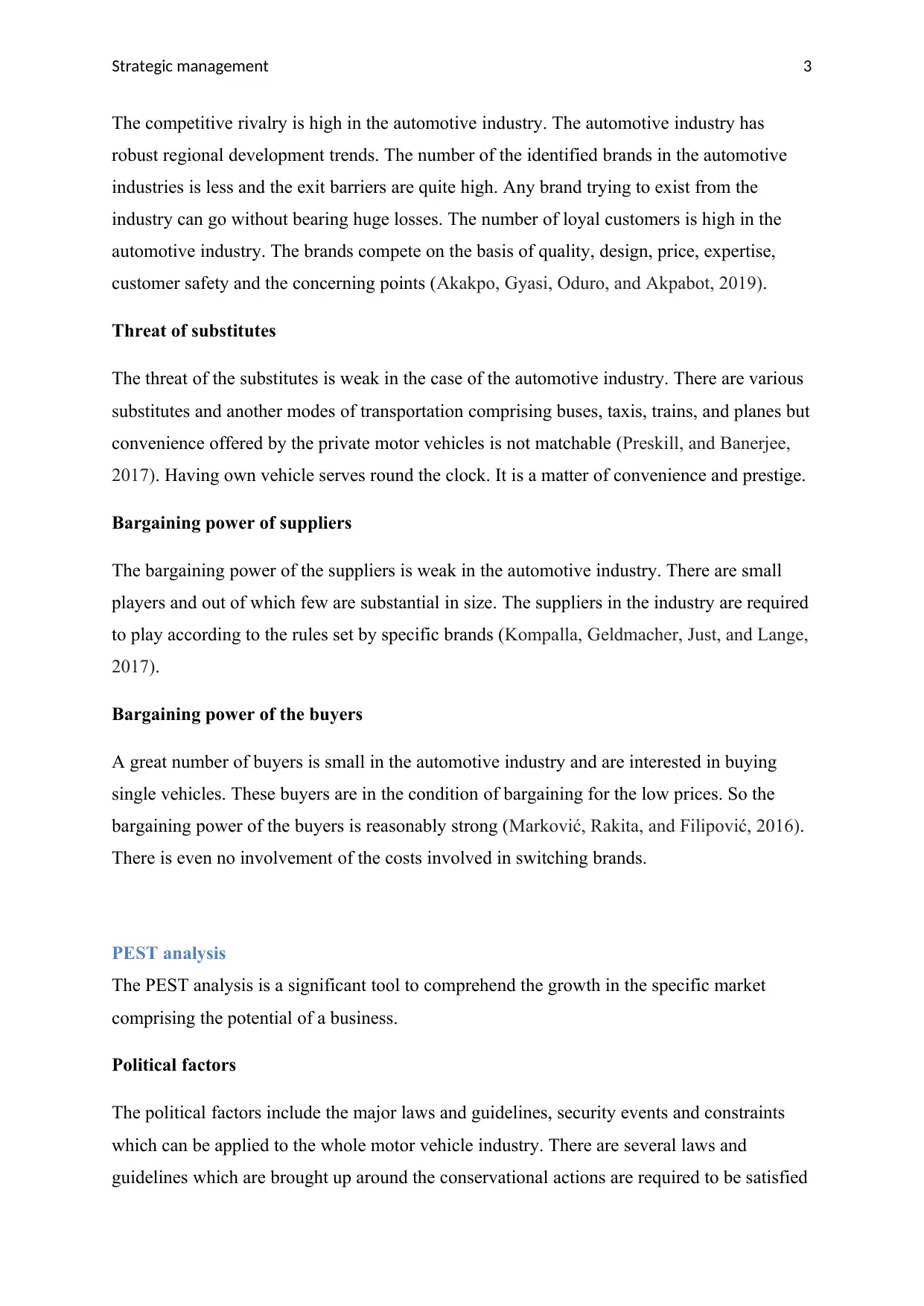
Strategic management 3
The competitive rivalry is high in the automotive industry. The automotive industry has
robust regional development trends. The number of the identified brands in the automotive
industries is less and the exit barriers are quite high. Any brand trying to exist from the
industry can go without bearing huge losses. The number of loyal customers is high in the
automotive industry. The brands compete on the basis of quality, design, price, expertise,
customer safety and the concerning points (Akakpo, Gyasi, Oduro, and Akpabot, 2019).
Threat of substitutes
The threat of the substitutes is weak in the case of the automotive industry. There are various
substitutes and another modes of transportation comprising buses, taxis, trains, and planes but
convenience offered by the private motor vehicles is not matchable (Preskill, and Banerjee,
2017). Having own vehicle serves round the clock. It is a matter of convenience and prestige.
Bargaining power of suppliers
The bargaining power of the suppliers is weak in the automotive industry. There are small
players and out of which few are substantial in size. The suppliers in the industry are required
to play according to the rules set by specific brands (Kompalla, Geldmacher, Just, and Lange,
2017).
Bargaining power of the buyers
A great number of buyers is small in the automotive industry and are interested in buying
single vehicles. These buyers are in the condition of bargaining for the low prices. So the
bargaining power of the buyers is reasonably strong (Marković, Rakita, and Filipović, 2016).
There is even no involvement of the costs involved in switching brands.
PEST analysis
The PEST analysis is a significant tool to comprehend the growth in the specific market
comprising the potential of a business.
Political factors
The political factors include the major laws and guidelines, security events and constraints
which can be applied to the whole motor vehicle industry. There are several laws and
guidelines which are brought up around the conservational actions are required to be satisfied
The competitive rivalry is high in the automotive industry. The automotive industry has
robust regional development trends. The number of the identified brands in the automotive
industries is less and the exit barriers are quite high. Any brand trying to exist from the
industry can go without bearing huge losses. The number of loyal customers is high in the
automotive industry. The brands compete on the basis of quality, design, price, expertise,
customer safety and the concerning points (Akakpo, Gyasi, Oduro, and Akpabot, 2019).
Threat of substitutes
The threat of the substitutes is weak in the case of the automotive industry. There are various
substitutes and another modes of transportation comprising buses, taxis, trains, and planes but
convenience offered by the private motor vehicles is not matchable (Preskill, and Banerjee,
2017). Having own vehicle serves round the clock. It is a matter of convenience and prestige.
Bargaining power of suppliers
The bargaining power of the suppliers is weak in the automotive industry. There are small
players and out of which few are substantial in size. The suppliers in the industry are required
to play according to the rules set by specific brands (Kompalla, Geldmacher, Just, and Lange,
2017).
Bargaining power of the buyers
A great number of buyers is small in the automotive industry and are interested in buying
single vehicles. These buyers are in the condition of bargaining for the low prices. So the
bargaining power of the buyers is reasonably strong (Marković, Rakita, and Filipović, 2016).
There is even no involvement of the costs involved in switching brands.
PEST analysis
The PEST analysis is a significant tool to comprehend the growth in the specific market
comprising the potential of a business.
Political factors
The political factors include the major laws and guidelines, security events and constraints
which can be applied to the whole motor vehicle industry. There are several laws and
guidelines which are brought up around the conservational actions are required to be satisfied
Paraphrase This Document
Need a fresh take? Get an instant paraphrase of this document with our AI Paraphraser
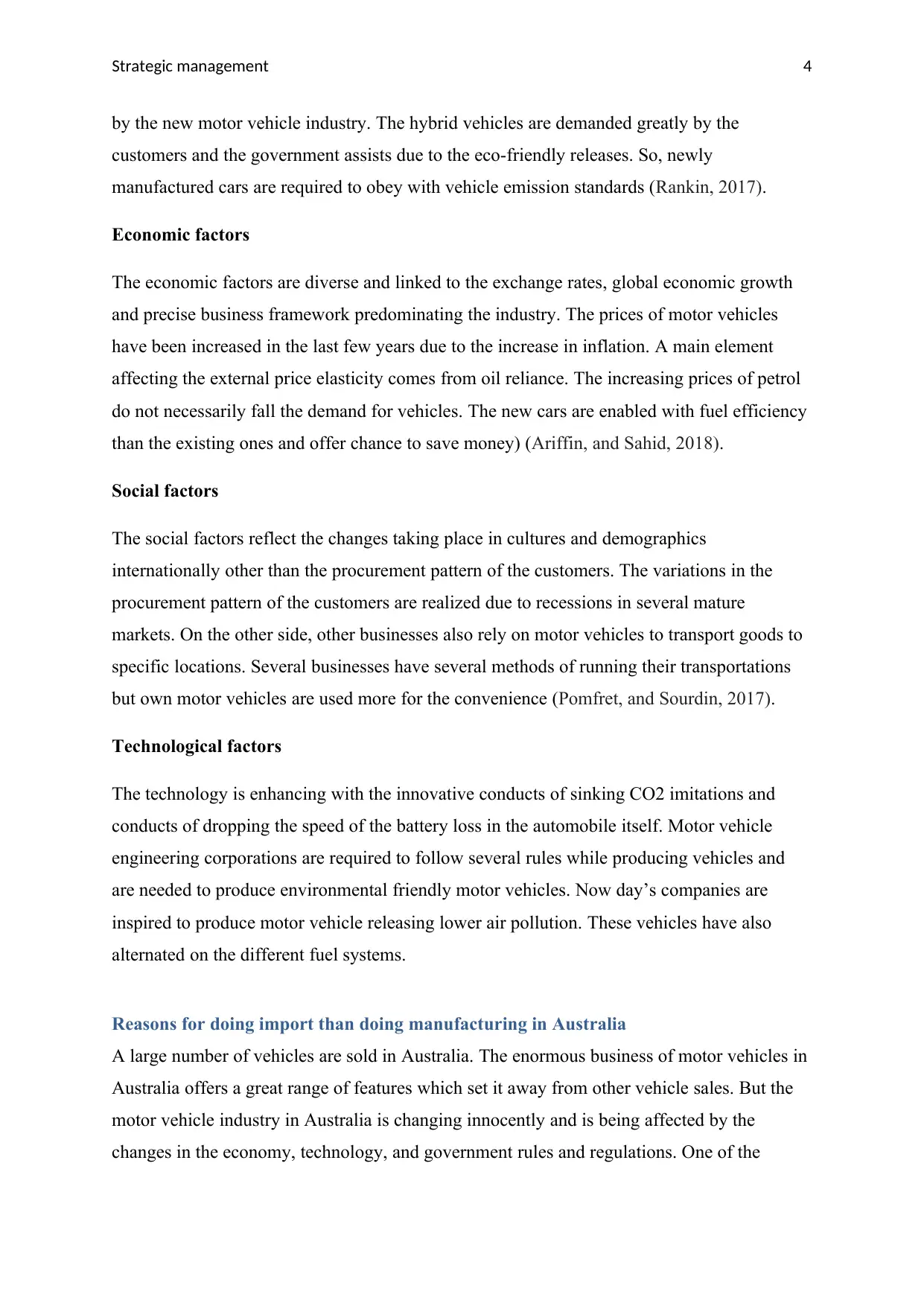
Strategic management 4
by the new motor vehicle industry. The hybrid vehicles are demanded greatly by the
customers and the government assists due to the eco-friendly releases. So, newly
manufactured cars are required to obey with vehicle emission standards (Rankin, 2017).
Economic factors
The economic factors are diverse and linked to the exchange rates, global economic growth
and precise business framework predominating the industry. The prices of motor vehicles
have been increased in the last few years due to the increase in inflation. A main element
affecting the external price elasticity comes from oil reliance. The increasing prices of petrol
do not necessarily fall the demand for vehicles. The new cars are enabled with fuel efficiency
than the existing ones and offer chance to save money) (Ariffin, and Sahid, 2018).
Social factors
The social factors reflect the changes taking place in cultures and demographics
internationally other than the procurement pattern of the customers. The variations in the
procurement pattern of the customers are realized due to recessions in several mature
markets. On the other side, other businesses also rely on motor vehicles to transport goods to
specific locations. Several businesses have several methods of running their transportations
but own motor vehicles are used more for the convenience (Pomfret, and Sourdin, 2017).
Technological factors
The technology is enhancing with the innovative conducts of sinking CO2 imitations and
conducts of dropping the speed of the battery loss in the automobile itself. Motor vehicle
engineering corporations are required to follow several rules while producing vehicles and
are needed to produce environmental friendly motor vehicles. Now day’s companies are
inspired to produce motor vehicle releasing lower air pollution. These vehicles have also
alternated on the different fuel systems.
Reasons for doing import than doing manufacturing in Australia
A large number of vehicles are sold in Australia. The enormous business of motor vehicles in
Australia offers a great range of features which set it away from other vehicle sales. But the
motor vehicle industry in Australia is changing innocently and is being affected by the
changes in the economy, technology, and government rules and regulations. One of the
by the new motor vehicle industry. The hybrid vehicles are demanded greatly by the
customers and the government assists due to the eco-friendly releases. So, newly
manufactured cars are required to obey with vehicle emission standards (Rankin, 2017).
Economic factors
The economic factors are diverse and linked to the exchange rates, global economic growth
and precise business framework predominating the industry. The prices of motor vehicles
have been increased in the last few years due to the increase in inflation. A main element
affecting the external price elasticity comes from oil reliance. The increasing prices of petrol
do not necessarily fall the demand for vehicles. The new cars are enabled with fuel efficiency
than the existing ones and offer chance to save money) (Ariffin, and Sahid, 2018).
Social factors
The social factors reflect the changes taking place in cultures and demographics
internationally other than the procurement pattern of the customers. The variations in the
procurement pattern of the customers are realized due to recessions in several mature
markets. On the other side, other businesses also rely on motor vehicles to transport goods to
specific locations. Several businesses have several methods of running their transportations
but own motor vehicles are used more for the convenience (Pomfret, and Sourdin, 2017).
Technological factors
The technology is enhancing with the innovative conducts of sinking CO2 imitations and
conducts of dropping the speed of the battery loss in the automobile itself. Motor vehicle
engineering corporations are required to follow several rules while producing vehicles and
are needed to produce environmental friendly motor vehicles. Now day’s companies are
inspired to produce motor vehicle releasing lower air pollution. These vehicles have also
alternated on the different fuel systems.
Reasons for doing import than doing manufacturing in Australia
A large number of vehicles are sold in Australia. The enormous business of motor vehicles in
Australia offers a great range of features which set it away from other vehicle sales. But the
motor vehicle industry in Australia is changing innocently and is being affected by the
changes in the economy, technology, and government rules and regulations. One of the
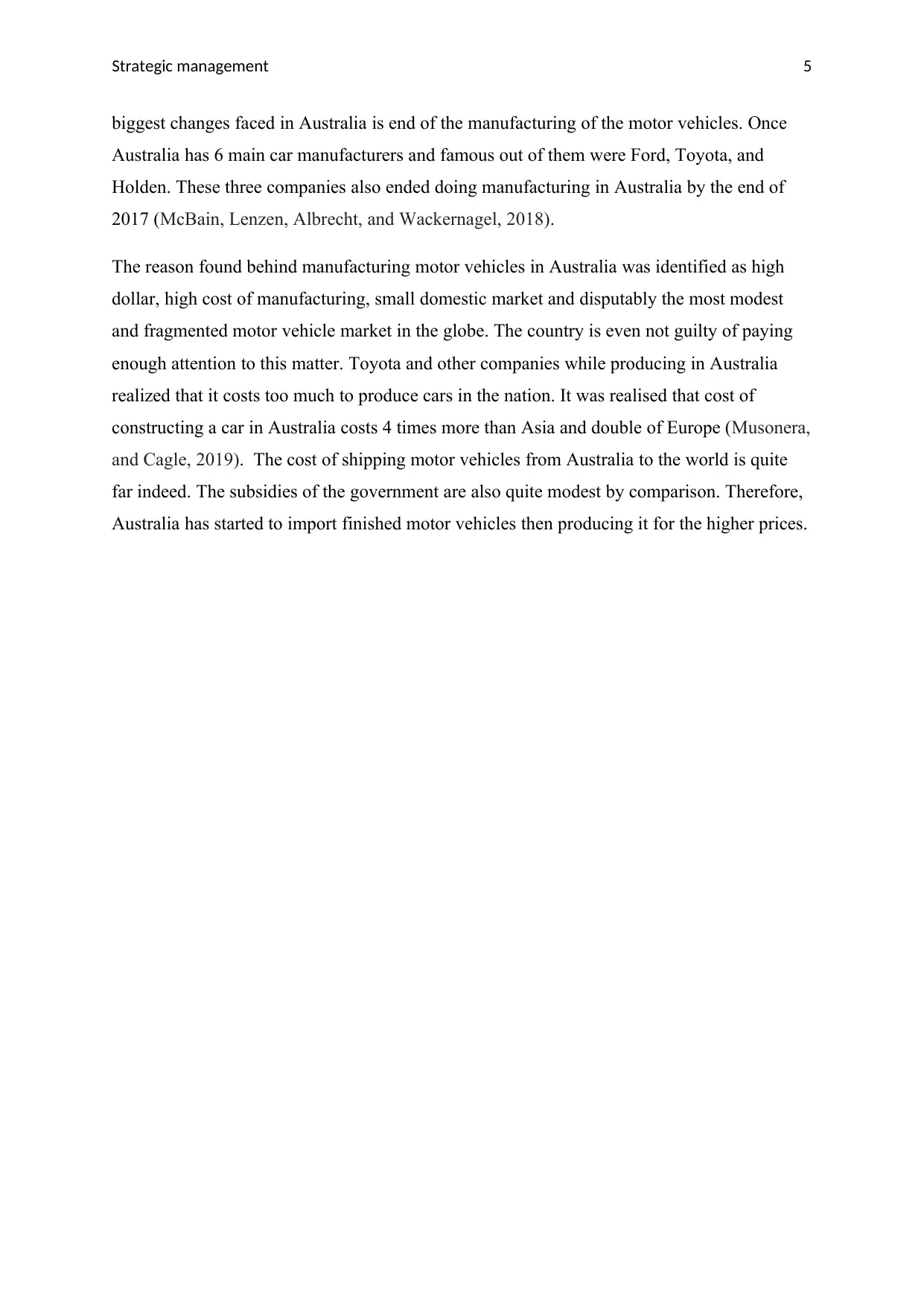
Strategic management 5
biggest changes faced in Australia is end of the manufacturing of the motor vehicles. Once
Australia has 6 main car manufacturers and famous out of them were Ford, Toyota, and
Holden. These three companies also ended doing manufacturing in Australia by the end of
2017 (McBain, Lenzen, Albrecht, and Wackernagel, 2018).
The reason found behind manufacturing motor vehicles in Australia was identified as high
dollar, high cost of manufacturing, small domestic market and disputably the most modest
and fragmented motor vehicle market in the globe. The country is even not guilty of paying
enough attention to this matter. Toyota and other companies while producing in Australia
realized that it costs too much to produce cars in the nation. It was realised that cost of
constructing a car in Australia costs 4 times more than Asia and double of Europe (Musonera,
and Cagle, 2019). The cost of shipping motor vehicles from Australia to the world is quite
far indeed. The subsidies of the government are also quite modest by comparison. Therefore,
Australia has started to import finished motor vehicles then producing it for the higher prices.
biggest changes faced in Australia is end of the manufacturing of the motor vehicles. Once
Australia has 6 main car manufacturers and famous out of them were Ford, Toyota, and
Holden. These three companies also ended doing manufacturing in Australia by the end of
2017 (McBain, Lenzen, Albrecht, and Wackernagel, 2018).
The reason found behind manufacturing motor vehicles in Australia was identified as high
dollar, high cost of manufacturing, small domestic market and disputably the most modest
and fragmented motor vehicle market in the globe. The country is even not guilty of paying
enough attention to this matter. Toyota and other companies while producing in Australia
realized that it costs too much to produce cars in the nation. It was realised that cost of
constructing a car in Australia costs 4 times more than Asia and double of Europe (Musonera,
and Cagle, 2019). The cost of shipping motor vehicles from Australia to the world is quite
far indeed. The subsidies of the government are also quite modest by comparison. Therefore,
Australia has started to import finished motor vehicles then producing it for the higher prices.
⊘ This is a preview!⊘
Do you want full access?
Subscribe today to unlock all pages.

Trusted by 1+ million students worldwide
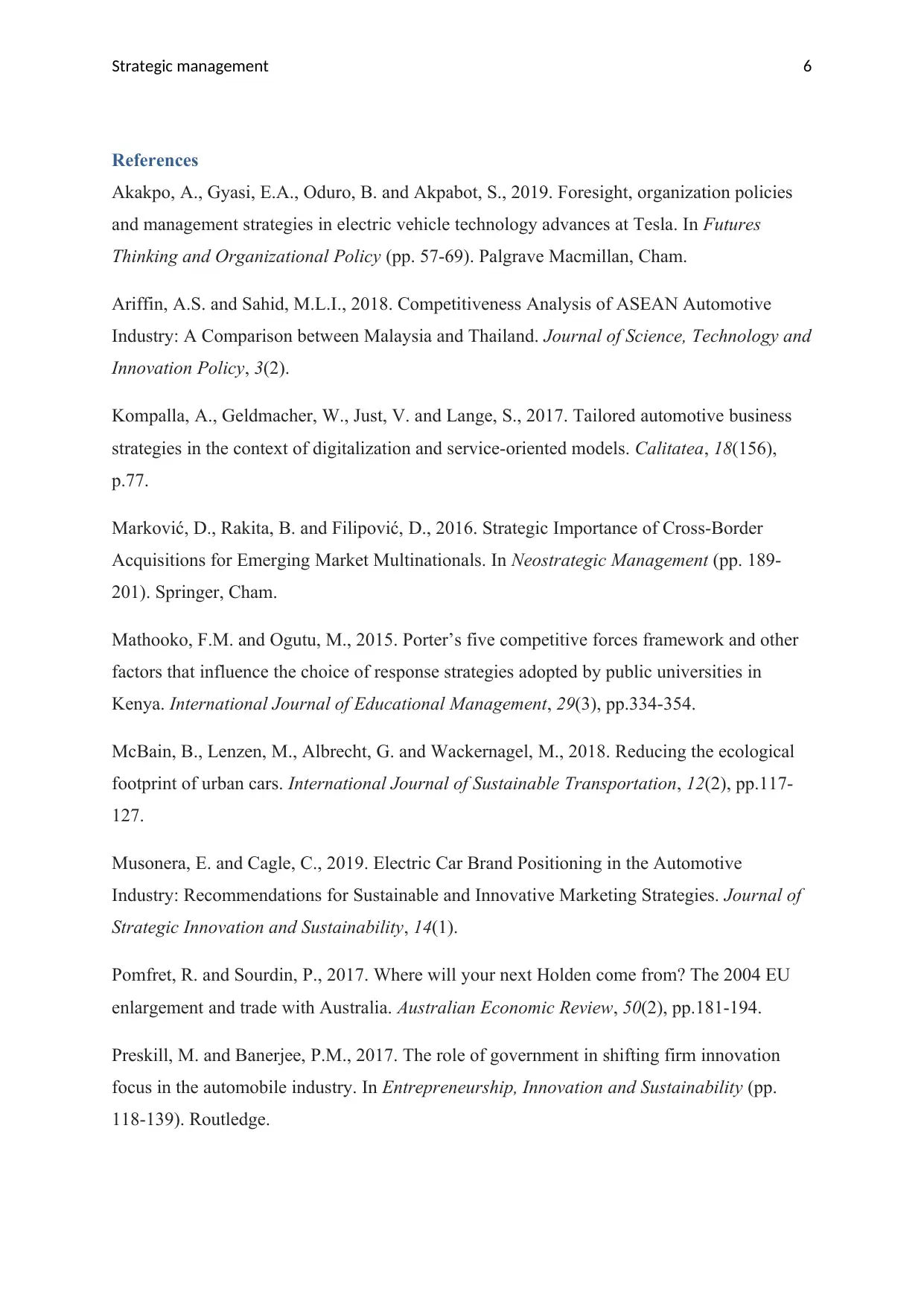
Strategic management 6
References
Akakpo, A., Gyasi, E.A., Oduro, B. and Akpabot, S., 2019. Foresight, organization policies
and management strategies in electric vehicle technology advances at Tesla. In Futures
Thinking and Organizational Policy (pp. 57-69). Palgrave Macmillan, Cham.
Ariffin, A.S. and Sahid, M.L.I., 2018. Competitiveness Analysis of ASEAN Automotive
Industry: A Comparison between Malaysia and Thailand. Journal of Science, Technology and
Innovation Policy, 3(2).
Kompalla, A., Geldmacher, W., Just, V. and Lange, S., 2017. Tailored automotive business
strategies in the context of digitalization and service-oriented models. Calitatea, 18(156),
p.77.
Marković, D., Rakita, B. and Filipović, D., 2016. Strategic Importance of Cross-Border
Acquisitions for Emerging Market Multinationals. In Neostrategic Management (pp. 189-
201). Springer, Cham.
Mathooko, F.M. and Ogutu, M., 2015. Porter’s five competitive forces framework and other
factors that influence the choice of response strategies adopted by public universities in
Kenya. International Journal of Educational Management, 29(3), pp.334-354.
McBain, B., Lenzen, M., Albrecht, G. and Wackernagel, M., 2018. Reducing the ecological
footprint of urban cars. International Journal of Sustainable Transportation, 12(2), pp.117-
127.
Musonera, E. and Cagle, C., 2019. Electric Car Brand Positioning in the Automotive
Industry: Recommendations for Sustainable and Innovative Marketing Strategies. Journal of
Strategic Innovation and Sustainability, 14(1).
Pomfret, R. and Sourdin, P., 2017. Where will your next Holden come from? The 2004 EU
enlargement and trade with Australia. Australian Economic Review, 50(2), pp.181-194.
Preskill, M. and Banerjee, P.M., 2017. The role of government in shifting firm innovation
focus in the automobile industry. In Entrepreneurship, Innovation and Sustainability (pp.
118-139). Routledge.
References
Akakpo, A., Gyasi, E.A., Oduro, B. and Akpabot, S., 2019. Foresight, organization policies
and management strategies in electric vehicle technology advances at Tesla. In Futures
Thinking and Organizational Policy (pp. 57-69). Palgrave Macmillan, Cham.
Ariffin, A.S. and Sahid, M.L.I., 2018. Competitiveness Analysis of ASEAN Automotive
Industry: A Comparison between Malaysia and Thailand. Journal of Science, Technology and
Innovation Policy, 3(2).
Kompalla, A., Geldmacher, W., Just, V. and Lange, S., 2017. Tailored automotive business
strategies in the context of digitalization and service-oriented models. Calitatea, 18(156),
p.77.
Marković, D., Rakita, B. and Filipović, D., 2016. Strategic Importance of Cross-Border
Acquisitions for Emerging Market Multinationals. In Neostrategic Management (pp. 189-
201). Springer, Cham.
Mathooko, F.M. and Ogutu, M., 2015. Porter’s five competitive forces framework and other
factors that influence the choice of response strategies adopted by public universities in
Kenya. International Journal of Educational Management, 29(3), pp.334-354.
McBain, B., Lenzen, M., Albrecht, G. and Wackernagel, M., 2018. Reducing the ecological
footprint of urban cars. International Journal of Sustainable Transportation, 12(2), pp.117-
127.
Musonera, E. and Cagle, C., 2019. Electric Car Brand Positioning in the Automotive
Industry: Recommendations for Sustainable and Innovative Marketing Strategies. Journal of
Strategic Innovation and Sustainability, 14(1).
Pomfret, R. and Sourdin, P., 2017. Where will your next Holden come from? The 2004 EU
enlargement and trade with Australia. Australian Economic Review, 50(2), pp.181-194.
Preskill, M. and Banerjee, P.M., 2017. The role of government in shifting firm innovation
focus in the automobile industry. In Entrepreneurship, Innovation and Sustainability (pp.
118-139). Routledge.
Paraphrase This Document
Need a fresh take? Get an instant paraphrase of this document with our AI Paraphraser
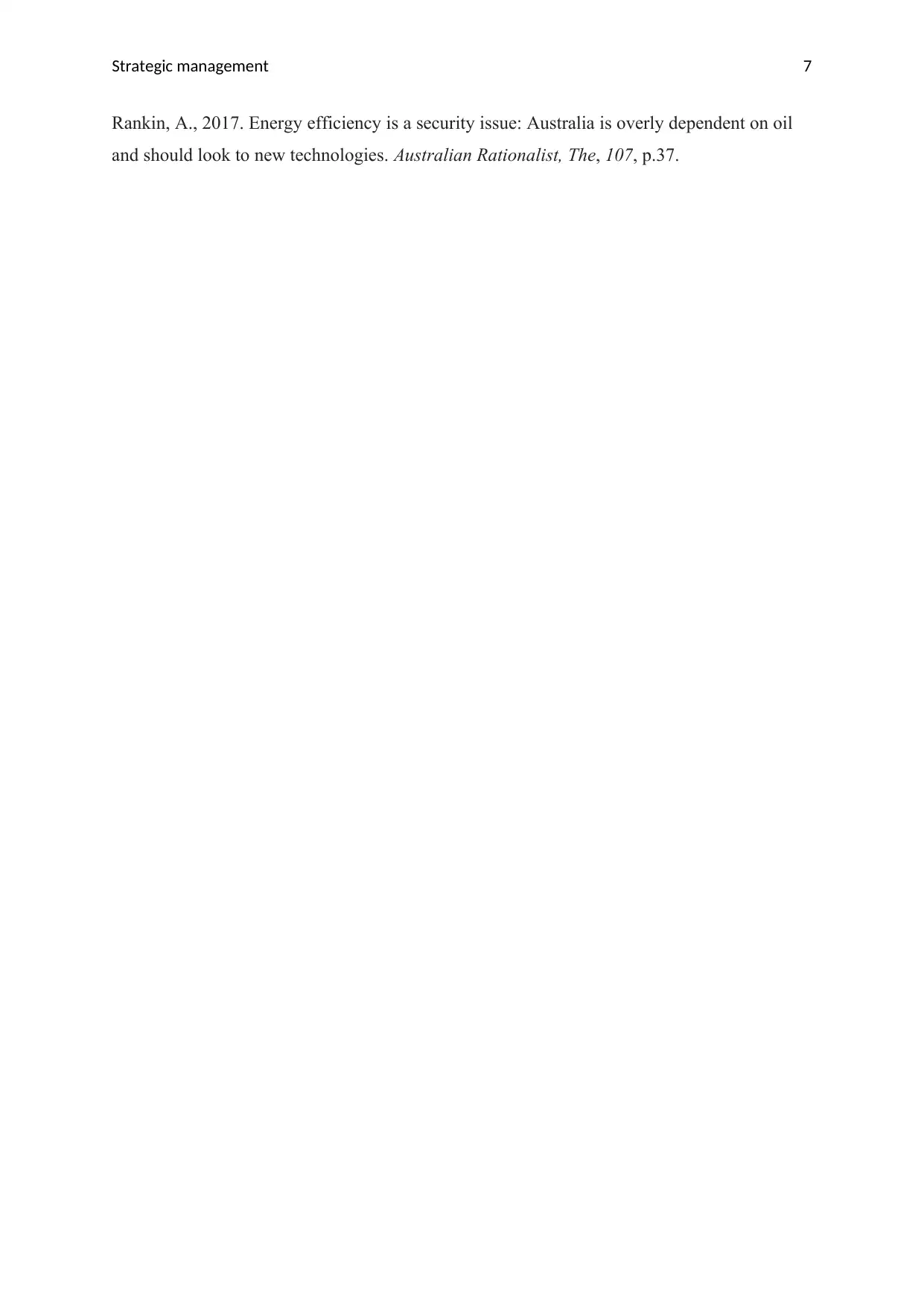
Strategic management 7
Rankin, A., 2017. Energy efficiency is a security issue: Australia is overly dependent on oil
and should look to new technologies. Australian Rationalist, The, 107, p.37.
Rankin, A., 2017. Energy efficiency is a security issue: Australia is overly dependent on oil
and should look to new technologies. Australian Rationalist, The, 107, p.37.
1 out of 8
Related Documents
Your All-in-One AI-Powered Toolkit for Academic Success.
+13062052269
info@desklib.com
Available 24*7 on WhatsApp / Email
![[object Object]](/_next/static/media/star-bottom.7253800d.svg)
Unlock your academic potential
Copyright © 2020–2025 A2Z Services. All Rights Reserved. Developed and managed by ZUCOL.





